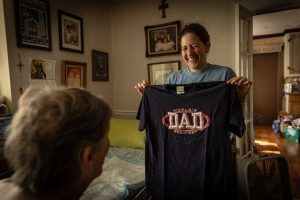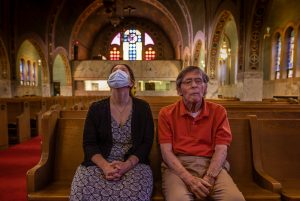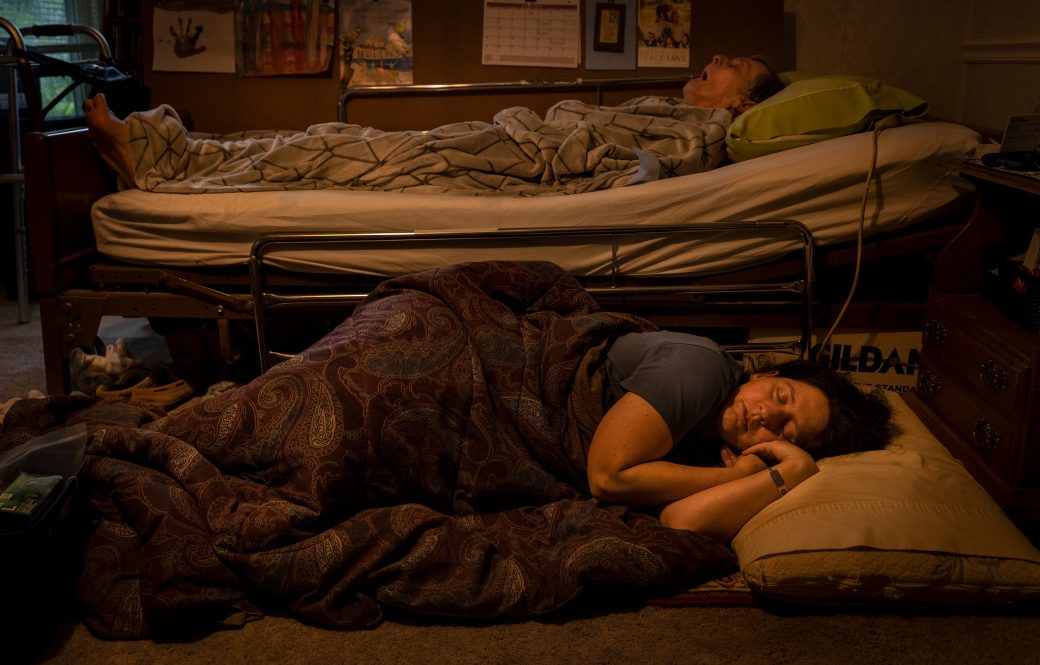Steven G. Smith wrestled with how to portray death in his latest documentary, “A Caregiver’s Journey.”
Invariably, Alzheimer’s disease ends with the loss of a loved one, but Smith didn’t want his film to dwell on the eventual. He spent the last year capturing footage to commemorate the devotion of a caregiver during a time that’s oftentimes disheartening and discouraging. There are enough raw images from daily life to anticipate the inevitable.
“I wanted the story to be inspiring because this is a depressing issue, there’s already enough sadness around it,” Smith, a Journalism Department professor in the College of Liberal Arts and Sciences, says. “I wanted to find somebody who was succeeding to their best and to try to give some people a level of understanding.”
He found that person in Manchester resident Leandra Manos, who brought her father, George, into her home at the start of the pandemic to care for him as the disease advances. The two agreed to the scope of the project and welcomed Smith into their world with cameras in hand to document daily chores, uplifting moments, and painful realities.
The resulting project – for now the photographic essay “A Daughter’s Long Goodbye, A Caregiver’s Journey” while Smith finishes the film’s final cut this spring – has earned recognition from Pictures of the Year International as a finalist in the Issue Reporting Picture Story category and in the Northern Short Course Photo & Multimedia Contest with a first place in News Picture Story.

“Obviously, as a journalist I’m objective, and there are many things I’m trained to do to tell both sides of the story,” Smith says. “But with a story like this, it’s critical that I’m building a rapport with, and respect for, the subjects I’m working with, all the while trying to do my best to do justice with the story. I feel a high degree of responsibility with that.”
There’s also the responsibility that comes with being a child of someone with Alzheimer’s.
Smith’s father was diagnosed five years ago in his home state of Washington, putting 3,000 miles between the two during a time when family ties already are strained as relationships slowly become one-sided.
Smith’s initial interest in Alzheimer’s came about after his father was diagnosed, and he wanted to learn all he could about what his mother was going through as a caregiver and what was physically happening to his dad. He put aside other film projects and shifted priorities when the idea for this one nagged.
“Working on this story, I’ve sat through many hours with social workers and Leandra, who let me in on those discussions,” he says. “You can imagine I’m taking notes not just for my story, but as a learning process.”
Manos and Smith connected online in a forum for caregivers where he proposed the project and put out a call to work with someone nearby. Back then, George Manos still had long periods of rational thought and agreed on his own to participate. Leandra Manos has an interest in writing, and thought she might contribute an essay to the full project someday.
“I sat down for probably several hours, maybe as many as three hours before I even brought a camera, just talking to Leandra, outside in the early spring last year, about the story and her circumstances and her dad’s circumstances,” Smith says. “She’s made tremendous sacrifices and she’s really an inspiration, her love and her dedication. She’s sacrificed pretty much everything to care for her father. She’s very patient with him, which I find to be very inspiring, because there’s something about this that can be frustrating. It’s not so much you’re frustrated with the human being; you’re frustrated with the disease itself and what it’s doing to them.”
In one picture from a session together, Smith photographed Leandra and George Manos sitting in a pew at St. Spyridon Greek Orthodox Cathedral in Worcester, Massachusetts. Leandra Manos is connected to her surroundings, eyes fixed on something above her whether spiritual or tangible, while George Manos gazes distantly ahead.
“This is their home church, and one of the things dementia does is just steal an awareness of what’s going on,” Smith says of the photograph. “She’s very engaged, and he’s there but he’s not. He’s not even thinking about his life and raising his children there, all the things that would flood back normally.”

Other images show just what Manos does for her father and all the routine care a person would need. In captions to the still images, Smith notes that Manos left full-time work, rented out the top floor of her home to earn an income, converted the front room of the first floor into a suitable living space, and plunged in as a 24/7 caregiver.
Respite nurses give her time to step away, but being the primary caregiver is an omnipresent responsibility, Smith explains, so much so that Manos has made her bed on the floor beside her father’s to keep him from wandering in the middle of the night.
“That’s loving, caring commitment, it says a lot of things there,” Smith says of the image.
When the three commenced the project, Smith says Manos urged him to portray the harsh realities that come with Alzheimer’s, not gloss over the crudest parts of what the disease brings.
Eventually, that’s death.
On Sept. 22, Manos lay on the floor of an exam room at Bolton Veterinary Hospital, curled up for the last time with her 14-year-old dog, Tiki, who had cancer and was to be euthanized. The film shows those last moments together – caregiver and companion – wrestling with death.
It’s a critical scene in the film.
“I’ve somewhat come to peace with it,” Smith says of his father’s diagnosis. “I can’t tell you I had peace with it before – and maybe peace isn’t the right word, maybe it’s understanding. Maybe that’s what I was searching for, some level of understanding.”



